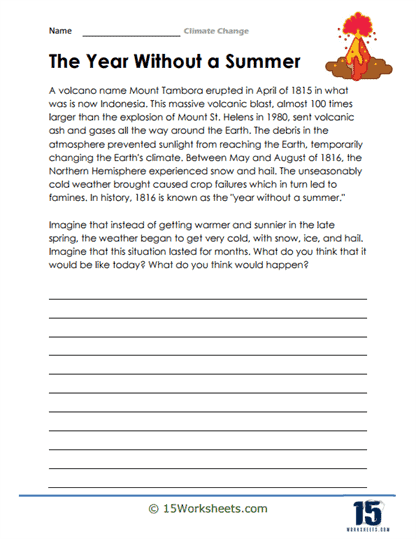The Year Without a Summer

Worksheet Description
Imagine that instead of getting warmer and sunnier in the late spring, the weather began to get very cold, with snow, ice, and hail. Imagine that this situation lasted for months. What do you think that it would be like today? What do you think would happen?
The worksheet offers an historical account of the colossal eruption of Mount Tambora in 1815, an event that led to severe climatic changes for the subsequent year. The volcanic eruption in Indonesia, which was significantly more powerful than the 1980 Mount St. Helens explosion, released vast amounts of ash and gas, obstructing sunlight and thereby altering the Earth’s climate temporarily. As a consequence of this eruption and the subsequent atmospheric changes, 1816 witnessed uncharacteristic cold weather patterns, leading to crop failures and widespread famines. This unusual year is historically recognized as the “Year without a summer.”
To engage effectively with this worksheet, students should start by reading the provided historical account attentively, ensuring comprehension of the sequence of events and their repercussions. After grasping the narrative, they should then employ critical thinking to contemplate the hypothetical situation posed: how would modern society react if a similar climatic event were to occur now? Students should consider the sociopolitical, environmental, and economic implications of such a scenario, documenting their thoughts and predictions in the space provided. Collaborative discussions with peers or research into similar historical events might further bolster their insights and answers.
The primary educational intent of this worksheet is to expose students to the profound and wide-reaching impacts that natural events, such as volcanic eruptions, can have on the Earth’s climate and, subsequently, human societies. By weaving a narrative around a historical occurrence, the worksheet endeavors to make the abstract concept of climate change more tangible and relatable. The inclusion of a hypothetical scenario prompts students to apply their understanding in a modern context, fostering critical thinking about the potential consequences and society’s adaptability. Through this lens, learners gain a deeper appreciation for the intricate relationship between the Earth’s natural phenomena and the well-being of its inhabitants.
